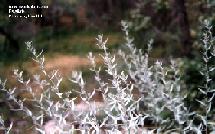

Western Mugwort
(White Sage)
Artemisia ludoviciana Nutt.
Western Mugwort is a perennial from underground stems that root from the
nodes). This aromatic plant may be over 3 feet tall.. Stems and leaves are
usually white from the presence of fine hairs. The lance-shaped leaves are
mostly about 1-3 inches long and irregularly toothed. Hundreds of tiny yellowish
flower heads form on the upper branches. Fruits are tiny with no bristles. It
blooms after mid-July on native prairie. It grows in dry open places and is
widespread throughout the Central and Western States. It is found on the Fort
Hall Indian Reservation in Southeastern Idaho.
Medicinal Uses:
White sage is used by American Indians as a medicine for bruises,
children's ailments, common cold, cough, eye ailments, gastro-intestinal
disturbances, gunshot wounds, itch, morning sickness, nerves, orthopedic
ailments, poison ivy, pulmonary ailments, respiratory ailments, skin ailments,
sore, stomach ache, throat ailments, tuberculosis, venereal ailments, women's
ailments, and Rocky Mountain Spotted Fever. The leaves were, dried, and crushed
and used as snuff to for congestion and headaches. The leaves could, also, be
chewed or powdered and applied to cuts, sores, and blisters.